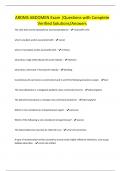Essay
BTEC Applied Science Unit 12C - Treatment of infectious diseases (Distinction)
- Course
- Institution
Exemplar assignment for Unit 12C of BTEC Level 3 Applied Science. This assignment was given a distinction. If you take anything from this assignment, PLEASE put it in your own words otherwise it will count as plagiarism. I hope it helps!
[Show more]












